- Home
- The Summer Garden
- Lilies
Gorgeous Lilies Make the Summer Border Special
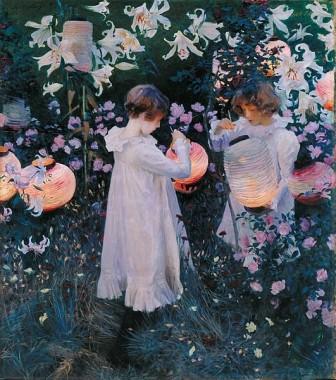 Carnation, Lily, Lily, Rose by John Singer Sargent/Public Domain
Carnation, Lily, Lily, Rose by John Singer Sargent/Public DomainThere are many plants that are called lilies, such as daylilies, crinum lilies, blackberry lilies, pineapple lilies, spider lilies, calla lilies, etc., but true lilies are separate and distinct. They grow from true bulbs which separate into scales rather like a garlic bulb. Lilies are some of the most romantic and mesmerizing summer bulbs one can grow.
This lovely painting by John Singer Sargent captures the magic of a summer’s eve in a garden filled with lilies and roses. Not only are they beautiful and elegant, but many of them have delicious, intoxicating perfumes that fill the garden air. Some of the lilies with the loveliest scents include Lilium regale, the regal lily; Lilium henryi, Henry’s lily; Lilium longiflorum, the Easter lily; Lilium speciosum var. rubrum ‘Uchida;’ and hybrids like the very popular ‘Casa Blanca,’ ‘Stargazer,’ and ‘Scheherazade,' and many more.
Lilies are hardy perennials, long-lived and many of them are quite easy to grow. They prefer full sun, consistent moisture, good drainage with humusy soil with a little grit, and pH on the acid side. They like to be left undisturbed and will get more beautiful each year. The biggest cause of lily failure is root rot, especially in the winter, so do be careful to provide excellent drainage.
Because there are so many species and hybrids of species and crosses that have been developed, lilies are organized into nine divisions. However, unless you are a grower or interested in raising lilies to hybridize or show, you needn’t be too concerned about the classifications. We just want the most beautiful ones (and the easiest to grow).
Asiatic Hybrid Lilies
Asiatic hybrids, Zones 4-9. Start your lily season with early-blooming Asiatic lilies. These lilies are easy to grow and they make great border plants as well as container subjects. They generally grow on straight stems that usually don’t require staking and have lots of buds for a long bloom period. Some are fragrant, some are not. There is a wide color selection including white, yellow, orange, pink, red and purple and combinations. Some examples include 'Bestseller,’ yellow w/orange; ‘Cogoleto,’ pink; ‘Elodie,’ soft pink; ‘Gran Paradiso,’ red; ‘Heartstrings,’ raspberry red/yellow; and ‘Mont Blanc,’ white.
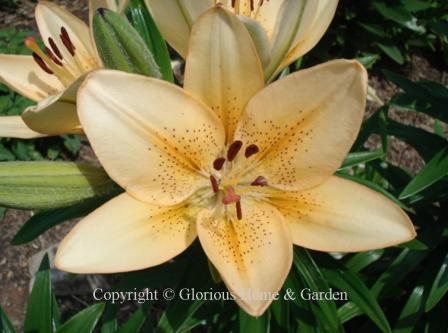 Lilium 'Bestseller'
Lilium 'Bestseller' Lilium 'Heartstrings'
Lilium 'Heartstrings'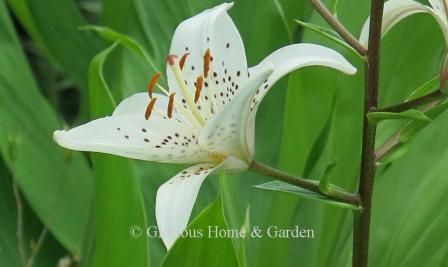 Lilium 'Mont Blanc'
Lilium 'Mont Blanc'Martagon Lilies
Lilium martagon and hybrids. Martagon lily or Turk's cap, Zones 3-9. Martagon lilies originated in Europe and Asia and have been crossed with L. hansonii to create garden hybrids. Candelabra-like racemes arise with Turk's cap type blooms. Warning: Martagon lilies are particularly toxic to cats.
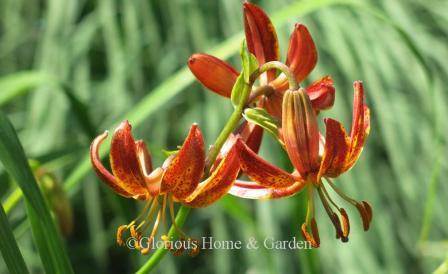 Lilium martagon 'Arabian Knight'
Lilium martagon 'Arabian Knight'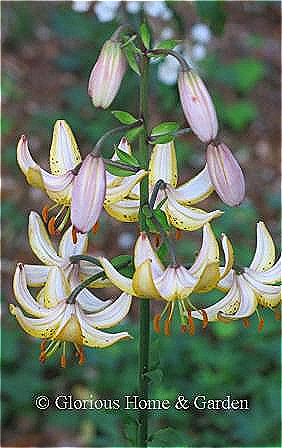 Lilium martagon 'Guinea Gold'
Lilium martagon 'Guinea Gold'Oriental Hybrid Lilies
Oriental hybrids, Zones
5-9. Considered the prima donnas of the lily world,
Oriental hybrids are crosses of certain lily species and recrossed with hybrids to create
large, very fragrant, long-lasting flowers with pizazz. Some of the most famous lilies are in this
group including 'Casa Blanca' and 'Stargazer.'
These lilies bloom in mid-to-late summer extending the lily season often
into fall. Grow these beauties in full
sun to partial shade, in moist, but well-drained acidic soil where you can
appreciate their perfume. But be aware,
if you have deer in your area, they do relish them like candy, so some
protection may be necessary. Some good
ones to try include ‘Anouska,’ double white w/pink edges (also
called a Roselily); ‘Casa Blanca,’ white; ‘Le Reve,’ pink; Muscadet,’
white with pink spots; ‘Stargazer,’ raspberry red; and ‘Tom Pouce,’ lavender
pink with yellow center stripe. The Romance® Series (represented here by 'Fine Romance') is bred to be shorter in height, about 18-20" making them perfect for containers.
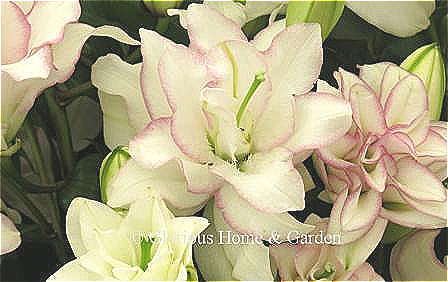 Lilium 'Anouska,' Double Oriental or Roselily.
Lilium 'Anouska,' Double Oriental or Roselily.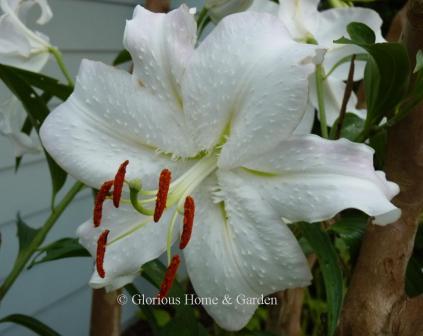 Lilium 'Casa Blanca'
Lilium 'Casa Blanca'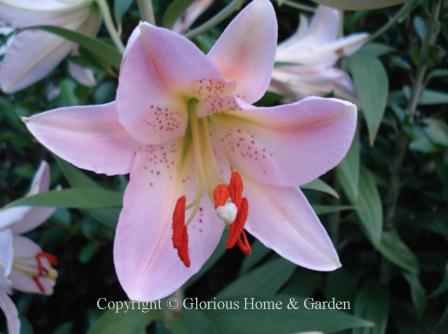 Lilium 'Le Reve'
Lilium 'Le Reve'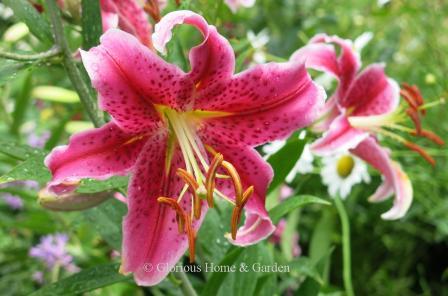 Lilium 'Stargazer'
Lilium 'Stargazer'"Orienpet" Lilies
Oriental/trumpet hybrids known as “Orienpet,” or "OT," Zones 5-9. These fabulous lilies are crosses between Oriental lilies and trumpet lilies. They bloom mid to late summer on strong stems that may bear 20-50 large fragrant blooms at maturity. Some favorites include ‘Anastasia,’ a wide white flower flushed with pink and with darker pink bands down the center of each petal; ‘Black Beauty,’ recurved like a Turk’s cap, dark raspberry petals edged with white and a green star heart; ‘Conca d’Or,’ luscious lemon yellow with darker yellow center; ‘Saronno,’ white with yellow throat; 'Scheherazade', recurved rosy red flowers with lighter edges.
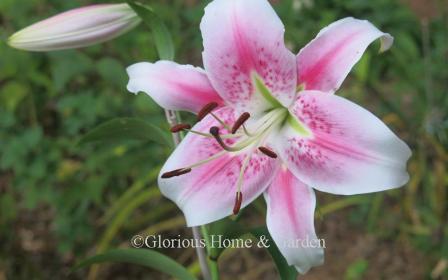 Lilium 'Anastasia'
Lilium 'Anastasia'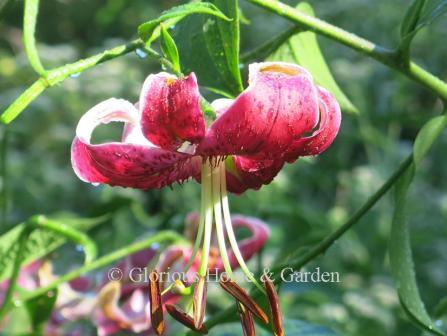 Lilium 'Black Beauty'
Lilium 'Black Beauty'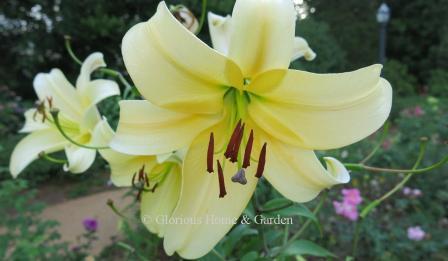 Lilium 'Conca d'Or'
Lilium 'Conca d'Or'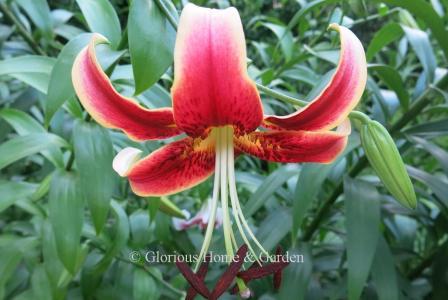 Lilium 'Scheherazade'
Lilium 'Scheherazade'Species Lilies
Lilium auratum, goldband lily, Zones 4-9. This is a gorgeous lily—white with central bands of gold down the center of each petal and flecked with crimson dots. It is also one of the most fragrant.
Lilium candidum, Madonna lily, Zones 4-9. The regal Madonna lily has been grown for centuries and is famously depicted in art with the Virgin Mary as a symbol of purity. The large white outward-facing trumpet shaped blooms are elegant and exude a lovely fragrance. They bloom in early-to-mid summer. Plant them in borders or containers in full sun to part shade about 4-6” apart in well-drained but moisture retentive soil with only about 1” of soil covering them. Warning: This species is very toxic to cats.
Lilium henryi, Henry’s lily, Zones 4-8. This species lily has orange petals that are deeply recurved—even more so than a turk’s cap—but is not fragrant. It grows to about 3-6’ and gets more floriferous with maturity. This is a long-lasting lily for the mid-to-late summer garden that gets better over time.
Lilium lancifolium, tiger lily, Zones 3-9. Also known as L. tigrinum, the tiger lily is an Asian species that has become naturalized in parts of the U.S. However, it is a known virus carrier that can infect other lily species and hybrids. They are also prolific multipliers from the numerous bulbils that form in the leaf axils and fall to the ground and germinate. They have been known to dominate garden beds and are difficult to eradicate if they get out of hand. But they are beautiful plants, no doubt, so if you segregate them from your other lilies and faithfully remove the bulbils before they fall to the ground, why not give them a try? But to me, with so many other wonderful lilies to grow, why take the risk of disease and thuggery? So, if I need a tall orange lily, I will consider L. henryi or L. superbum for a similar look without the issues.
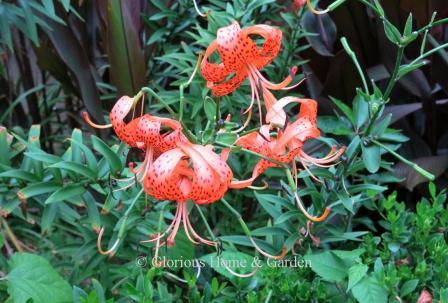 Lilium lancefolium
Lilium lancefoliumLilium lancifolium var. ‘Flore-Pleno,’ Zones 3-9. The double form of the tiger lily. Quite spectacular.
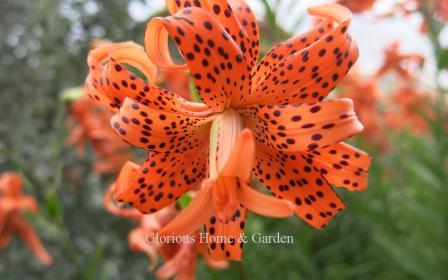 Lilium lancifolium var. 'Flore-Pleno'
Lilium lancifolium var. 'Flore-Pleno'Lilium longiflorum, Easter lily, Zones 8-11. This is the beloved lily sold everywhere at Easter time, but it is interesting that the lilies have to be forced into bloom for Easter because their normal bloom time is in the summer. Should you receive one as a gift, you can plant it out in the garden when frost danger is past. Easter lilies love to be planted in full sun, in rich soil with good drainage.
Lilium philippinense, Philippine or benguet lily, Zones 7-11. A very tall (up to 6’) and highly fragrant white lily with an elongated trumpet and reflexed petals. Does best in full sun with rich soil.
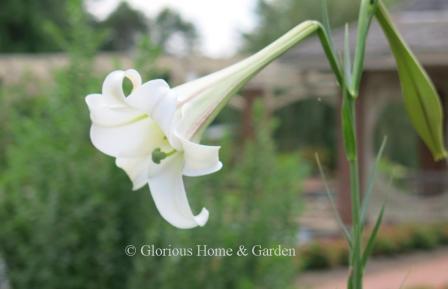 Lilium philippenense
Lilium philippenenseLilium regale, regal or king’s lily, Zones 3-8. One of the world’s most treasured lilies, discovered by Ernest Henry Wilson on one of his plant exploration trips to China in 1903. If I could choose only one lily to grow, I’d be perfectly satisfied with this one. The pure white interior with yellow throat and exterior streaked with purple is lovely, and they have a divine fragrance that can perfume the entire garden. A well-grown mature clump, that can reach 4-6’, is an impressive sight.
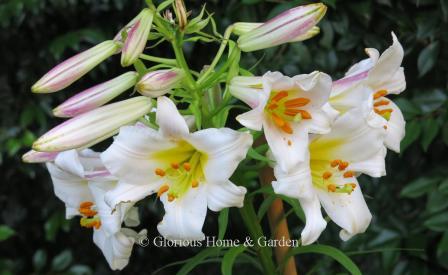 Lilium regale
Lilium regaleLilium speciosum var. rubrum ‘Uchida,’ Zones 3-8. One of the last lilies to bloom in late summer, ‘Uchida’ is a lovely pink spangled with pink freckles, recurved petals and a delicious fragrance. One of the best. From Japan.
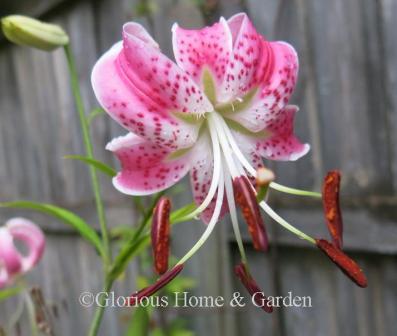 Lilium speciosum var. rubrum 'Uchida'
Lilium speciosum var. rubrum 'Uchida'Lilium superbum, Turk's cap lily, Zones 4-8. This lily is native to the eastern and central U.S. where it occurs near wetlands and moist woodlands. The spotted orange blooms recurve giving it a turban effect. It also does well in full sun to partial shade in average garden soils where it gets consistent moisture.
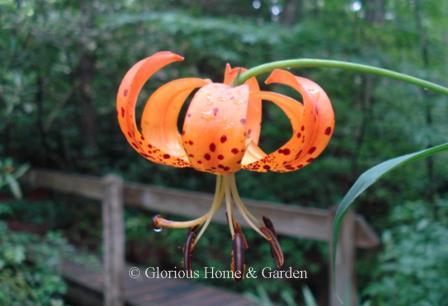 Lilium superbum
Lilium superbumPlant of the Month

Ilex verticillata
Winterberry holly
Updated new USDA Plant Hardiness Zone Map 2023.